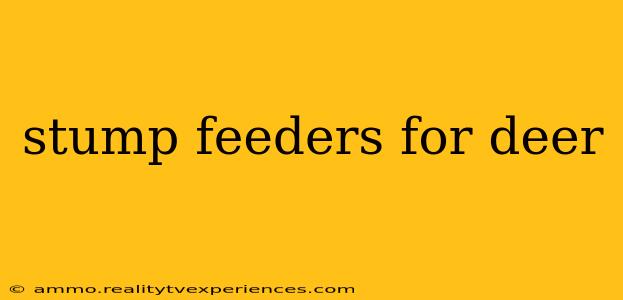Deer hunting and management often involve supplemental feeding, and stump feeders have emerged as a popular choice among landowners and hunters. This comprehensive guide explores the benefits, drawbacks, and considerations when using stump feeders for deer. We'll cover everything from choosing the right type to proper placement and maintenance.
Understanding the Appeal of Stump Feeders
Stump feeders offer a unique blend of practicality and effectiveness in attracting and feeding deer. Their design incorporates several advantages that make them stand out from traditional feeders:
Concealment and Durability:
- Camouflage: The natural appearance of a stump blends seamlessly with the surrounding environment, providing excellent concealment for the feeder and reducing spooking of deer. This is particularly beneficial in areas with high hunting pressure.
- Robust Construction: Many stump feeders are built from durable materials like treated wood or metal, offering resistance to weather damage and vandalism, ensuring a longer lifespan than some other feeder types.
Efficient Feeding:
- Controlled Dispensing: Some models offer controlled dispensing of feed, preventing waste and attracting unwanted animals. This ensures your deer get the nutrition they need without attracting excessive pests.
- Reduced Spoilage: The enclosed nature of many stump feeders can help protect feed from rain and snow, minimizing spoilage and maximizing your investment.
Ease of Use:
- Simple Filling: Most stump feeders are designed for easy filling, minimizing the time and effort required for maintenance.
- Minimal Maintenance: Their durable construction and design often require less maintenance compared to other feeder types.
Types of Stump Feeders Available
The market offers a variety of stump feeders, each with its own features and benefits. Here's a look at some common types:
Wooden Stump Feeders:
These are often crafted from treated lumber, offering a natural camouflage and durability. Their appearance seamlessly integrates with the surrounding environment, minimizing disturbance to deer.
Metal Stump Feeders:
Metal stump feeders provide superior durability and protection against pests and weather. They are often more resistant to damage compared to wooden options.
Combination Stump Feeders:
Some feeders blend wood and metal components, combining the aesthetic appeal of wood with the durability of metal. This hybrid approach balances functionality and visual integration into the environment.
Choosing the Right Stump Feeder: Key Considerations
Selecting the appropriate stump feeder involves considering several factors:
Capacity:
Choose a feeder with a capacity that aligns with your feeding needs and the number of deer in your area. Larger feeders reduce the frequency of refills but might be more expensive.
Material:
Consider the durability and longevity of the material. Treated wood offers a natural look, while metal provides superior resistance to damage.
Dispensing Mechanism:
Some feeders feature gravity-fed systems, while others incorporate controlled-release mechanisms. Consider your needs and the type of feed you'll be using.
Placement and Maintenance: Maximizing Effectiveness
Optimal placement and regular maintenance significantly impact the success of your stump feeder.
Ideal Location:
- Concealment: Place the feeder in a location that provides natural concealment and minimizes disturbance to deer.
- Accessibility: Ensure the feeder is accessible for easy filling and maintenance.
- Proximity to Cover: Locate the feeder near cover such as trees or brush, allowing deer to feel secure while feeding.
- Avoid Water Sources: Prevent the feeder from attracting unwanted animals or getting damaged by placing it away from water sources.
Regular Maintenance:
- Cleaning: Regularly clean the feeder to prevent mold and pest infestations.
- Refilling: Maintain adequate feed levels to prevent competition and spoilage.
- Inspection: Periodically inspect the feeder for damage or deterioration.
Conclusion: A Smart Choice for Deer Feeding
Stump feeders present a practical and effective solution for managing and supplementing deer populations. By understanding the different types, considering key factors when selecting a feeder, and implementing proper placement and maintenance strategies, you can maximize their effectiveness and create a successful deer feeding program. Remember to consult with local wildlife experts for specific guidelines in your region.

